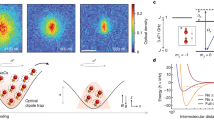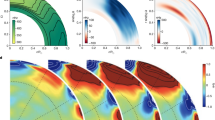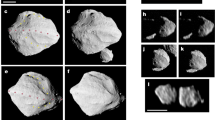Abstract
Antiprotons (p̄) are expected to be found in the cosmic rays at the level of ∼10−4 relative to protons (p) as they should be produced by cosmic-ray proton collisions with the interstellar medium1–3. The recent observations of Buffington et al.4 are puzzling, however, because the total p̄ flux observed is ∼10 times larger than predicted, and the shape of the p̄ spectrum differs greatly from that predicted. We explore here the possibility that primordial black holes (PBHs) of mass ∼1013 – 1015 g which evaporated after decoupling (t≳1014 s) are the primary source of the cosmic ray p̄s. The PBH scenario predicts a universal p̄/p ratio of ∼10−4–10−8.
This is a preview of subscription content, access via your institution
Access options
Subscribe to this journal
Receive 51 print issues and online access
$199.00 per year
only $3.90 per issue
Buy this article
- Purchase on Springer Link
- Instant access to full article PDF
Prices may be subject to local taxes which are calculated during checkout
Similar content being viewed by others
References
Gaisser, T. K. & Levy, E. H. Phys. Rev. D10, 1731 (1974).
Stephens, S. A. Astrophys. Space Sci. 76, 87 (1981).
Szabelski, J., Wdowczyk, J. & Wolfendale, A. W. Nature 285, 386 (1980).
Buffington, A. & Schindler, S. M. Astrophys J. Lett. 247, L105 (1981).
Golden, R. L. et al. Phys. Rev. Lett. 43, 1196 (1979).
Bogomolov, E. A. et al. Proc. 16th int. Cosmic Ray Conf., Kyoto, Vol. 1, 33 (1979).
Rasmussen, I. L. & Peater, B. Nature 258, 412 (1975).
Peters, B. & Westergaard, N. J. Astrophys. Space Sci. 48, 21 (1977).
Stephens, S. A. Astrophys. Space Sci. 76, 87 (1981).
Steigman, G. Astrophys. J. Lett. 217, L131 (1977).
Szabelski, J., Wdowczyk, J. & Wolfendale, A. W. Nature 285, 386 (1980).
Steigman, G. A. Rev. Astr. Astrophys. 14, 339 (1976).
Stecker, F. W., Protheroe, R. & Kazanas, D. Proc. 17th int. Cosmic Ray Conf., Paris (in the press).
Carr, B. J. Astrophys. J. 201, 1 (1975); 206, 8 (1976).
Turner, M. S. Phys. Lett. 89B, 155 (1979).
Hawking, S. W. Nature 248, 30 (1974).
Page, D. N. Phys. Rev. D13, 198 (1975).
Morgan, D. L. Jr & Hughes, V. W. Phys. Rev. D2, 1389 (1970).
Fitchel, C. E. et al. Astrophys. J. 198, 163 (1975).
Kiraly, P., Szabelski, J., Wdowczyk, J. & Wolfendale, A. W. Nature 293, 120 (1981).
Author information
Authors and Affiliations
Rights and permissions
About this article
Cite this article
Turner, M. Could primordial black holes be the source of the cosmic ray antiprotons?. Nature 297, 379–381 (1982). https://doi.org/10.1038/297379a0
Received:
Accepted:
Issue Date:
DOI: https://doi.org/10.1038/297379a0
This article is cited by
-
High-resolution laser resonances of antiprotonic helium in superfluid 4He
Nature (2022)
-
Relativistic Quantum Metrology in Open System Dynamics
Scientific Reports (2015)
-
Quantum Thermometry
Foundations of Physics (2014)
-
MASS-SAT: Matter-Antimatter Space Spectrometer on Satellite
Il Nuovo Cimento B Series 11 (1990)
-
Mass-height relation for antimatter meteors
Earth, Moon, and Planets (1990)
Comments
By submitting a comment you agree to abide by our Terms and Community Guidelines. If you find something abusive or that does not comply with our terms or guidelines please flag it as inappropriate.



